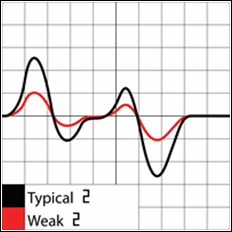 Whenever image or MICR failures occur, it’s common for customers to ask, “Is my scanner wearing out?” We receive such inquiries occasionally from users experiencing higher-than-usual failure rates that require manual entry on the MICR line – the magnetic ink that encodes account and routing information at the bottom of checks and money orders. Under normal circumstances, Digital Check’s scanners will produce MICR read rates approaching 100%, and our latest read heads are designed to interpret magnetic signals as weak as 20% of normal, as in the diagram at right. So if the number of MICR errors is noticeable, it’s time to look for the reason.
Whenever image or MICR failures occur, it’s common for customers to ask, “Is my scanner wearing out?” We receive such inquiries occasionally from users experiencing higher-than-usual failure rates that require manual entry on the MICR line – the magnetic ink that encodes account and routing information at the bottom of checks and money orders. Under normal circumstances, Digital Check’s scanners will produce MICR read rates approaching 100%, and our latest read heads are designed to interpret magnetic signals as weak as 20% of normal, as in the diagram at right. So if the number of MICR errors is noticeable, it’s time to look for the reason.
It’s true that a MICR head will eventually wear out: Components manufacturers typically rate their lifetime at about 500,000 scans before the microscopic abrasions caused by moving paper will begin to affect performance. However, we’ve seen them wear out in half that time if especially coarse paper is being scanned. We’ve also seen extreme examples of devices approaching 15 million items that are still functioning perfectly. The bottom line: Do keep track of how many checks you scan; if you are in a heavy-use situation, your device may be a candidate for MICR head replacement. However, it would be wise to investigate a few other possible causes first.
The great majority of MICR errors are caused by problem documents: Those with weak or non-conforming MICR, physical damage, or those that have been fed improperly. In many cases, the document quality is out of the receiving bank’s control:
- Customers who print their own checks with weak or no magnetic ink
- Incorrect MICR character spacing, especially on money orders
- Checks crumpled or folded along the MICR line, or with part of it rubbed out
In these cases, Digital Check tries to prevent errors with a variety of safeguards; our software will correct 2/3 of MICR substitutions using OCR, and 3/4 of can’t-read MICR characters. On the other hand, some fully preventable causes of MICR misreads or can’t-reads include:
- Checks inserted upside-down or backwards
- Documents misaligned in feeder
- Double-feeds
- Dust or dirt preventing direct contact with the read head
In these cases, some simple staff retraining or cleaning the device can reduce the number of exceptions you see. A few simple steps can help you keep your scanner operating properly:
1) Clean the scanner regularly according to the recommended guidelines – once every 5,000 to 8,000 items scanned. Removing dirt stuck to the rollers can prevent double-feeds, and blowing dust from the track eliminates obstructions.
2) Make sure your staff is careful about aligning checks before inserting them, and use a check jogger if stacks of documents tend to be thicker than is easy to straighten by hand. If a document is inserted a few millimeters out of true, part of the MICR text will likely pass above the top of the read head, creating a can’t-read error.
3) Be familiar with your normal MICR failure rate. If you sense that you are having to key MICR data more often, or having to re-scan items more frequently due to MICR errors, track how often the errors are occurring. If it is greater than your historical average, you may wish to investigate the above possibilities.
4) Do keep track of how many items the scanner has run since the MICR head was new. If the scanner has more than one half million scans, or if you know you tend to receive coarse paper documents, then the device could be a candidate for MICR head replacement.
With proper use and care, your scanner should continue operating at peak performance for many years.





